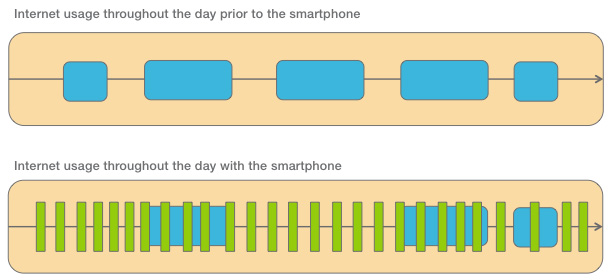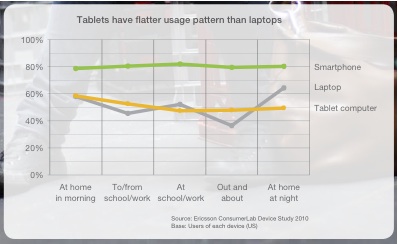Smartphones, tablets change how we use social
What did you do this morning after your alarm went off – other than hit the snooze button? If you’ve got a smartphone, a new study says, there’s about a one-in-three chance that you switched on your phone and loaded up an app. And if you’re in that group, chances are also pretty good that you checked Twitter, Facebook or some other social networking app; 18 percent of those users, for example, logged onto Facebook before they got out from under the covers.
While it’s kind of a silly statistic (and, if you’re a diehard Facebooker, maybe an obvious one), there are a few key points to take from the study, which was commissioned by Ericsson ConsumerLabs (yes, as in “Sony Ericsson,” the phone manufacturer – you can download the PDF here). One vital thing to note is something that isn’t even in the survey at all: It ignores how much we use our smartphones as, well, phones, compared to the myriad other things we do with these little magic bricks we keep in our pockets and purses. After all, how many of us actually make a call to relay the sorts of “I’m running late” messages that cell phones were originally sold on? These days a “be there in five” is more likely to come via text or tweet.
So maybe we all know that we’re using our smartphones to get online much, much more than we used to – and it’s not tied to being at home, at work or near our laptops – but what does that mean about our overall usage patterns? For one thing, all that old marketing advice about optimizing the best times of day to reach your audience may not be quite as valid any more. Check out this (maybe a little oversimplified) chart from the Ericsson survey:

Now, that’s not to say that time-of-day use has leveled out completely, especially if you’re offering a product, service or app that itself has a strong timeliness component. (As a news organization, we’re no exception – our daily traffic figures certainly show peaks and valleys that correspond with how you’d expect people would want to use a newspaper.) What it does mean, though, is that as you’re promoting your product or cause online, it may be worth concentrating a bit less on optimizing the times of day you speak and thinking a little more about what sort of device people might be on when you’re doing it. This could mean a lot of things: Don’t throw your audience a link to a third-party page that you know breaks on your phone’s browser. Don’t assume that someone on a smartphone has the time or the technical know-how to bookmark a link or save something to look at later. Ask yourself how someone on the go might react to your message, and see if there’s a way it might be useful or fun for them to interact with it via their phone.
Also, keep in mind that while the number of people looking at your stuff on a tablet might be small now, it’s certainly on the rise; when people surveyed were asked what their next gadget purchase would be, a tablet came in third (13 percent) after a new laptop (16 percent) and smartphone (19 percent). If you consider that the iPad is only a little over a year old, that’s a pretty significant ranking. Plus, those tablet owners are using their new devices in a manner that’s more like how they interact with a phone than with a computer, particularly when it comes to usage over the course of a day.

How about you – is a tablet on your wish list? If you already have one, do you use it more like a little laptop or a big smartphone? And (just because we’re curious) do you use your tablet or smartphone before you get out of bed in the morning? Tell us in the comments.

